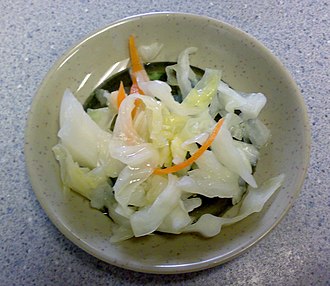Tsukemono






Tsukemono (Japanese: 漬物, literally "pickled things") are traditional Japanese pickles. Enjoyed with nearly every meal in Japan, tsukemono are not only a culinary staple but also an integral part of the country's culture and history. These pickled vegetables can range in flavor from sweet to sour, salty to spicy, and everything in between, providing a balance to richer dishes and enhancing the overall dining experience.
History[edit]
The tradition of making tsukemono dates back to ancient times, serving as a method for preserving food. The practice evolved over centuries, incorporating various techniques and ingredients. Initially, tsukemono were made simply by salting vegetables to preserve them. Over time, the methods became more sophisticated, including the use of rice bran (nukazuke), miso paste (misozuke), sake lees (sakezuke), and vinegar (suzuke), among others.
Types of Tsukemono[edit]
Several types of tsukemono are commonly found in Japanese cuisine, each with its unique preparation method and taste:
- Umeboshi (Japanese plum pickles) - These are sour and salty pickles made from ume fruits, often colored red with shiso leaves.
- Nukazuke (Rice bran pickles) - Vegetables fermented in a bed of rice bran, yielding a tangy taste.
- Misozuke (Miso pickles) - Vegetables pickled in miso paste, offering a rich, umami flavor.
- Shibazuke (Mixed vegetable pickles) - A mixture of vegetables, typically cucumber and eggplant, fermented in ume vinegar and shiso, known for its purple color.
- Takuan (Pickled daikon radish) - Yellow in color, these pickles are made from daikon radish fermented in rice bran or dried and then pickled in a mixture of salt, rice bran, and sugar.
Cultural Significance[edit]
Tsukemono hold a special place in Japanese culture, symbolizing the change of seasons and the preservation of food. They are an essential part of the Japanese tea ceremony and are often served as a side dish (okazu), with rice (as a palate cleanser), or with drinks (as an appetizer). The art of making tsukemono is passed down through generations, with each region in Japan having its unique variations and specialties.
Health Benefits[edit]
Tsukemono are not only valued for their taste but also for their health benefits. Rich in probiotics, particularly those made through fermentation, they aid in digestion and enhance gut health. They are also low in calories, making them a healthy addition to any meal.
Making Tsukemono[edit]
The process of making tsukemono varies depending on the type. However, the basic principle involves salting or pickling vegetables to alter their texture and flavor. Some methods require just a few hours, while others may take several months. The key to good tsukemono is the balance of saltiness, sweetness, acidity, and umami, which can be adjusted according to personal preference.
Conclusion[edit]
Tsukemono are a testament to the Japanese art of preservation, offering a glimpse into the country's culinary traditions and cultural heritage. With their diverse flavors and health benefits, these pickles continue to be a beloved part of Japanese cuisine.
Ad. Transform your life with W8MD's Budget GLP-1 injections from $75


W8MD offers a medical weight loss program to lose weight in Philadelphia. Our physician-supervised medical weight loss provides:
- Weight loss injections in NYC (generic and brand names):
- Zepbound / Mounjaro, Wegovy / Ozempic, Saxenda
- Most insurances accepted or discounted self-pay rates. We will obtain insurance prior authorizations if needed.
- Generic GLP1 weight loss injections from $75 for the starting dose.
- Also offer prescription weight loss medications including Phentermine, Qsymia, Diethylpropion, Contrave etc.
NYC weight loss doctor appointmentsNYC weight loss doctor appointments
Start your NYC weight loss journey today at our NYC medical weight loss and Philadelphia medical weight loss clinics.
- Call 718-946-5500 to lose weight in NYC or for medical weight loss in Philadelphia 215-676-2334.
- Tags:NYC medical weight loss, Philadelphia lose weight Zepbound NYC, Budget GLP1 weight loss injections, Wegovy Philadelphia, Wegovy NYC, Philadelphia medical weight loss, Brookly weight loss and Wegovy NYC
|
WikiMD's Wellness Encyclopedia |
| Let Food Be Thy Medicine Medicine Thy Food - Hippocrates |
Medical Disclaimer: WikiMD is not a substitute for professional medical advice. The information on WikiMD is provided as an information resource only, may be incorrect, outdated or misleading, and is not to be used or relied on for any diagnostic or treatment purposes. Please consult your health care provider before making any healthcare decisions or for guidance about a specific medical condition. WikiMD expressly disclaims responsibility, and shall have no liability, for any damages, loss, injury, or liability whatsoever suffered as a result of your reliance on the information contained in this site. By visiting this site you agree to the foregoing terms and conditions, which may from time to time be changed or supplemented by WikiMD. If you do not agree to the foregoing terms and conditions, you should not enter or use this site. See full disclaimer.
Credits:Most images are courtesy of Wikimedia commons, and templates, categories Wikipedia, licensed under CC BY SA or similar.
Translate this page: - East Asian
中文,
日本,
한국어,
South Asian
हिन्दी,
தமிழ்,
తెలుగు,
Urdu,
ಕನ್ನಡ,
Southeast Asian
Indonesian,
Vietnamese,
Thai,
မြန်မာဘာသာ,
বাংলা
European
español,
Deutsch,
français,
Greek,
português do Brasil,
polski,
română,
русский,
Nederlands,
norsk,
svenska,
suomi,
Italian
Middle Eastern & African
عربى,
Turkish,
Persian,
Hebrew,
Afrikaans,
isiZulu,
Kiswahili,
Other
Bulgarian,
Hungarian,
Czech,
Swedish,
മലയാളം,
मराठी,
ਪੰਜਾਬੀ,
ગુજરાતી,
Portuguese,
Ukrainian
